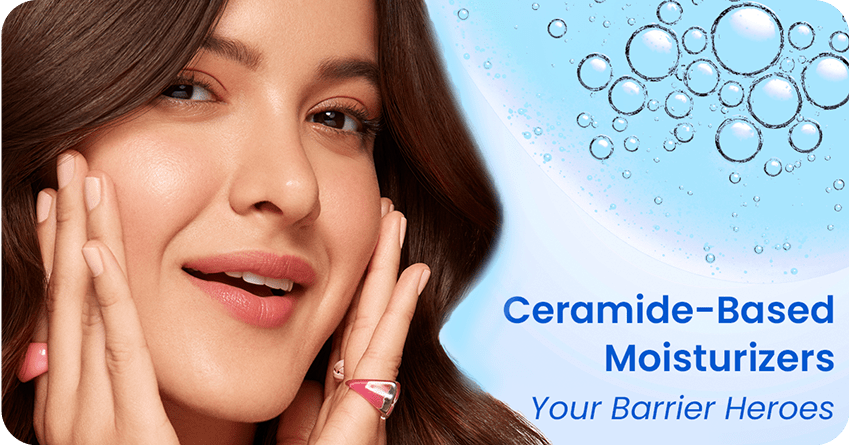Get Your AI Analysis
Personalized skincare insights
Discover your perfect skincare routine with our AI-powered analysis. Get personalized recommendations for glowing, healthy skin.
Start AnalysisFollow Us
Stay updated with the latest skincare tips, trends, and expert advice.
If your skin feels chronically dry, irritated, or sensitive no matter what you use, you're probably missing one critical ingredient: ceramides. These lipid molecules make up 50% of your skin's protective barrier—and when they're depleted, everything goes wrong.

Ceramides aren't flashy like retinol or trendy like niacinamide, but they're the foundation of healthy skin. Without them, even the most expensive serums won't work properly because your skin can't hold onto moisture or protect itself.
This complete guide will teach you everything about ceramides: what they do, why you need them, and how to use them for maximum benefit. Let's rebuild your barrier from the ground up.
What Are Ceramides? (The Science Made Simple)
Ceramides are fatty lipid molecules that naturally exist in the outermost layer of your skin (stratum corneum). Think of them as the "mortar" between the "bricks" (skin cells) in your skin's protective wall.
The Brick and Mortar Analogy:
Bricks (Corneocytes): Dead skin cells
Mortar (Lipids): 50% ceramides, 25% cholesterol, 15% fatty acids
When the mortar (ceramides) is intact, your skin barrier is strong. When ceramides are depleted, cracks form in the wall—water escapes, irritants enter, and skin becomes compromised.
What Ceramides Do:
✅ Lock in moisture (prevent transepidermal water loss)
✅ Protect against environmental damage
✅ Maintain optimal pH balance
✅ Prevent irritation and inflammation
✅ Support overall barrier integrity
Types of Ceramides (What You'll See on Labels)
There are 12 types of ceramides in human skin, but skincare products typically feature these key ones:
Most Common in Skincare:
Ceramide NP (Ceramide 3): Most abundant in skin, excellent for hydration
Ceramide AP (Ceramide 6-II): Supports cell renewal and barrier repair
Ceramide EOP (Ceramide 1): Critical for barrier structure
Ceramide NS (Ceramide 2): Hydration and barrier support
Ceramide AS (Ceramide 5): Anti-inflammatory properties
What you need to know: Products with multiple ceramide types are more effective than single-ceramide formulas. Look for at least 2-3 different ceramides on the ingredient list.
Signs Your Skin Needs More Ceramides
Check if you're experiencing 3+ of these symptoms:
❌ Chronic dryness that won't improve with moisturizer
❌ Increased sensitivity to products
❌ Tightness after cleansing
❌ Flaky, rough texture
❌ Redness and irritation
❌ Products sting or burn on application
❌ Skin feels "thin" or fragile
❌ Breakouts despite using gentle products
❌ More visible fine lines (from dehydration)
If you said yes to 3+, your skin barrier likely needs ceramide support.
Benefits of Ceramides for Every Skin Type
For Dry Skin:
Ceramides restore the lipid barrier, preventing water loss and locking in hydration. They're more effective than just using moisturizer alone.
For Sensitive/Reactive Skin:
Strengthens the barrier to keep irritants out, reducing redness, stinging, and inflammation. Ceramides are gentle and non-irritating for even the most reactive skin.
For Aging Skin:
Ceramide levels naturally decline with age (60% reduction by age 60!). Replenishing them plumps skin, smooths fine lines, and improves firmness.
For Acne-Prone Skin:
A compromised barrier triggers excess oil production and inflammation. Ceramides calm skin, reduce breakouts, and support healing without clogging pores.
For Oily Skin:
Yes, oily skin needs ceramides too! A damaged barrier causes skin to overproduce oil to compensate. Ceramides restore balance and reduce excess sebum.
Ceramides vs. Other Hydrators: What's the Difference?
Understanding how ceramides compare to other ingredients:
Ceramides vs. Hyaluronic Acid:
HA: Humectant that attracts water into skin (hydration)
Ceramides: Lipid that locks water in (barrier repair)
Best together: HA hydrates, ceramides seal it in
Ceramides vs. Niacinamide:
Niacinamide: Boosts natural ceramide production
Ceramides: Directly replenishes depleted ceramides
Best together: Niacinamide increases ceramide synthesis, while topical ceramides provide immediate replenishment
Ceramides vs. Peptides:
Peptides: Signal skin to produce collagen/elastin
Ceramides: Repair and protect the barrier
Different roles: Peptides for anti-aging, ceramides for barrier health
Best Ceramide Products (By Category)
Best Ceramide Cleansers (Cleanse Without Stripping)

1. CeraVe Hydrating Facial Cleanser
Price: ~$15
View on Amazon
Ceramides 1, 3, 6-II + hyaluronic acid
Non-foaming, ultra-gentle
Best for: All skin types, especially dry/sensitive
Best Ceramide Serums (Intensive Barrier Repair)
2. Dr. Jart+ Ceramidin Serum
Price: ~$48
View on Amazon
5-Cera complex
Lightweight, absorbs quickly
Best for: Dehydrated, compromised barriers
3. Elizabeth Arden Advanced Ceramide Capsules
Price: ~$68
View on Amazon
Single-dose capsules ensure potency
Ceramide NP + phytosphingosine
Best for: Anti-aging, mature skin
Best Ceramide Moisturizers (Daily Barrier Protection)
4. CeraVe Moisturizing Cream (Tub)
Price: ~$18
View on Amazon
The gold standard - proven effective
Ceramides 1, 3, 6-II + MVE technology (time-release)
Best for: All skin types, barrier SOS, affordable
Dermatologist favorite
5. La Roche-Posay Toleriane Double Repair Face Moisturizer
Price: ~$20
View on Amazon
Ceramide-3 + prebiotic thermal water
Lightweight, fast-absorbing
Best for: Sensitive, acne-prone, combination skin
6. Stratia Liquid Gold
Price: ~$28
View on Amazon
Ceramides + cholesterol + fatty acids in ideal 3:1:1 ratio
4% niacinamide boosts ceramide production
Best for: K-beauty fans, barrier repair enthusiasts
Indie cult favorite
Best Ceramide Treatments (Intensive Rescue)
7. La Roche-Posay Cicaplast Baume B5
Price: ~$15
View on Amazon
5% panthenol + madecassoside + copper-zinc-manganese complex
Speeds healing dramatically
Best for: Severely damaged barriers, post-procedure, eczema flares
8. First Aid Beauty Ultra Repair Cream
Price: ~$36
View on Amazon
Colloidal oatmeal + ceramides
Soothes eczema-prone skin
Best for: Very dry, itchy, irritated skin
How to Use Ceramides in Your Routine
Basic Ceramide Routine (Barrier Repair)
Morning:
Gentle ceramide cleanser (or just water)
Hydrating toner/essence
Ceramide serum
Ceramide moisturizer
Night:
Hydrating toner/essence
Ceramide serum
Ceramide moisturizer (thick layer)
Slugging (optional but recommended for severe dryness)
Layering Ceramides with Actives
Ceramides are the perfect support ingredient for active-heavy routines:
With Retinol:
Apply retinol first, wait 10 minutes
Follow with ceramide moisturizer
Ceramides minimize retinol irritation
With Exfoliants (AHA/BHA):
Use exfoliant 2-3x per week
Follow immediately with ceramides
Helps repair barrier after exfoliation
With Vitamin C:
Apply vitamin C first (AM)
Follow with ceramide serum + moisturizer
No conflicts—work beautifully together
When You'll See Results from Ceramides
Realistic timeline for ceramide benefits:
Days 1-3: Immediate hydration, less tightness
Week 1: Reduced sensitivity, calmer skin
Week 2: Improved texture, less flaking
Week 3-4: Significant barrier improvement, tolerates products better
6-8 weeks: Fully restored barrier, plumper skin, fewer fine lines
Important: Ceramides work cumulatively. Keep using them even after your barrier is healed for prevention and maintenance.
Can You Use Too Many Ceramides?
Short answer: No! Unlike active ingredients (retinol, acids, vitamin C), you can't "overdo" ceramides.
Why Ceramides Are Safe to Layer:
✅ They're naturally present in your skin
✅ Non-irritating and gentle
✅ Work synergistically with other lipids
✅ More ceramides = stronger barrier
Strategy: For severely damaged barriers, use multiple ceramide products (cleanser, serum, moisturizer) for maximum repair.
Ceramides for Different Skin Conditions
For Eczema (Atopic Dermatitis):
Eczema is directly linked to ceramide deficiency. Clinical studies show ceramide-rich moisturizers significantly improve eczema symptoms. Use ceramides 2x daily during flares.
For Rosacea:
Ceramides strengthen the barrier, reducing triggers that cause rosacea flares. Choose fragrance-free formulas with soothing ingredients like centella.
For Psoriasis:
While not a cure, ceramides help manage psoriasis by reducing water loss and supporting barrier function between flares.
For Post-Procedure Skin:
After laser, chemical peels, or microneedling, ceramides accelerate healing and reduce downtime. Start using them immediately after procedure (with doctor approval).
Boosting Your Natural Ceramide Production
Beyond topical ceramides, support your skin's natural ceramide synthesis:
Skincare Ingredients That Boost Ceramides:
Niacinamide (2-5%): Increases ceramide production by up to 34%
Linoleic Acid: Essential fatty acid that supports ceramide synthesis
Cholesterol + Fatty Acids: Work synergistically with ceramides in 3:1:1 ratio
Lifestyle Factors:
✅ Avoid hot water (strips ceramides)
✅ Use gentle, low-pH cleansers
✅ Protect from sun damage (UV degrades ceramides)
✅ Manage stress (cortisol depletes ceramides)
✅ Stay hydrated
What Depletes Ceramides? (Avoid These!)
Protect your natural ceramides by avoiding:
❌ Over-exfoliation (strips lipid barrier)
❌ Harsh sulfate cleansers
❌ Hot water showers/baths
❌ Unprotected sun exposure
❌ Smoking (reduces ceramide levels)
❌ High-pH products
❌ Fragranced products (can damage barrier)
Get Personalized Ceramide Recommendations
Not sure which ceramide products are right for your specific skin type and concerns? Our AI Skin Analysis can assess your barrier health and recommend a custom ceramide protocol tailored to your needs.

